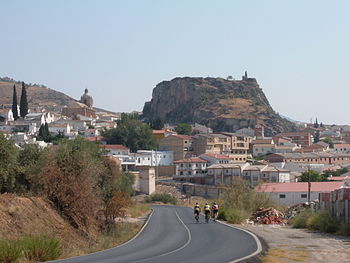Íllora
| Íllora | ||
|---|---|---|
| Municipality | ||

Íllora
|
||
|
||
| Location in Spain | ||
| Coordinates: 37°17′18″N 3°52′47″W / 37.28833°N 3.87972°W | ||
| Country | Spain | |
| Autonomous Community | Andalusia | |
| Province | Granada | |
| Comarca | Comarca de Loja | |
| Government | ||
| • Mayor | Francisco José Domene Rodríguez (PSOE) | |
| Area | ||
| • Total | 197.4 km2 (76.2 sq mi) | |
| Elevation(AMSL) | 759 m (2,490 ft) | |
| Population (2012) | ||
| • Total | 10,716 | |
| • Density | 54/km2 (140/sq mi) | |
| Time zone | CET (UTC+1) | |
| • Summer (DST) | CEST (GMT +2) (UTC+2) | |
| Postal code | 18260 | |
| Area code(s) | +34 (Spain) + 958 (Granada) | |
| Website | www.illora.com | |
Íllora is a municipality in the province of Granada, located in Andalucia. Spain. It is surrounded by the following villages: Moclín, Pinos Puente, Valderrubio, Moraleda de Zafayona, Villanueva Mesía, Montefrío, and with the municipality of Alcalá la Real. The municipality consists of Íllora, Alomartes, Tocón, Escóznar, Obéilar- also known as La Estación de Íllora–, Brácana, Ventas de Algarra, Vallequemado and La Alhondiguilla.
The main source of income is the rural economy, especially the olives.
Number of inhabitants in the past few years:
In June 1319, when the Vega of Granada was being devastated, the town of Íllora came into the possession of the infantes Pedro and Juan de Castilla. If they would have stayed one more day, affirms the Chronicle of Alfonso XI, they would have also taken its castle. The infante Pedro did not want to stay anymore, as his main ambition was to isolate Granada until they seized it. However, both infantes were killed in the Desastre de la Vega de Granada, which occurred 25 June 1319.
In the center of the village, on the top of a , stands the castle of Illora. Even though it is in ruins, part of the wall of the castle remains. It is from the Caliphal Period (9th and 10th centuries). It is divided in three main places: the villa, the alcazaba and the arrabal.
Moreover, there are some towers: The Torre de Brácana, for example. In Tocón there is another tower which is a rural castle. All of them belong to the Nasrid period.
Illora, furthermore, counts with another important historical-artistic monument (which was declared an Asset of Cultural Interest in 1980) is the church, Iglesia de Nuestra Señora de la Encarnación designed by Diego de Siloé who is also known for building Granada's cathedral in the 16th century, with the intervention of some disciples like Juan de Maeda and Diego de Pesquera.
The most important musical event which is celebrated in Illora is Parapanda Folk festival. It was declared to be of National Tourist Interest and takes place during the summer holidays, in the last week of July. It is performed by some national and international ethnic groups. This activity is considered to be culturally relevant.
The local festival in honor to San Rogelio takes place on the third weekend of August. Even though the actual day of San Rogelio is 16 September- which is also a festive day in the village. The local faire is from the 8–12 October. A long time ago was considered to be one of the most important of all Spain. Easter is one of the most important weeks of the whole year culturally and religiously.
...
Wikipedia


